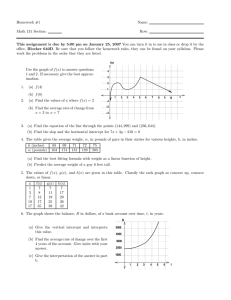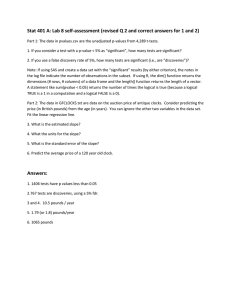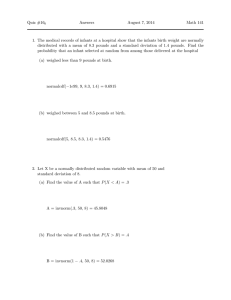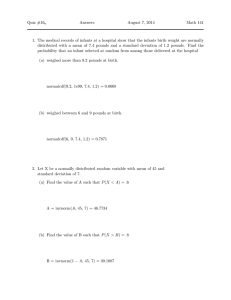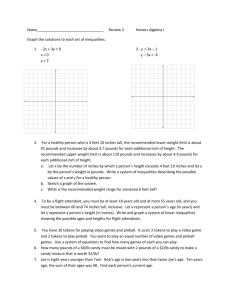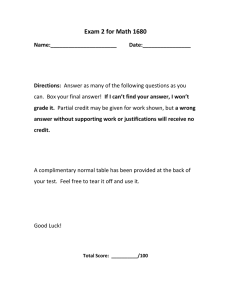Relationship between trout populations and cover on a small stream
advertisement
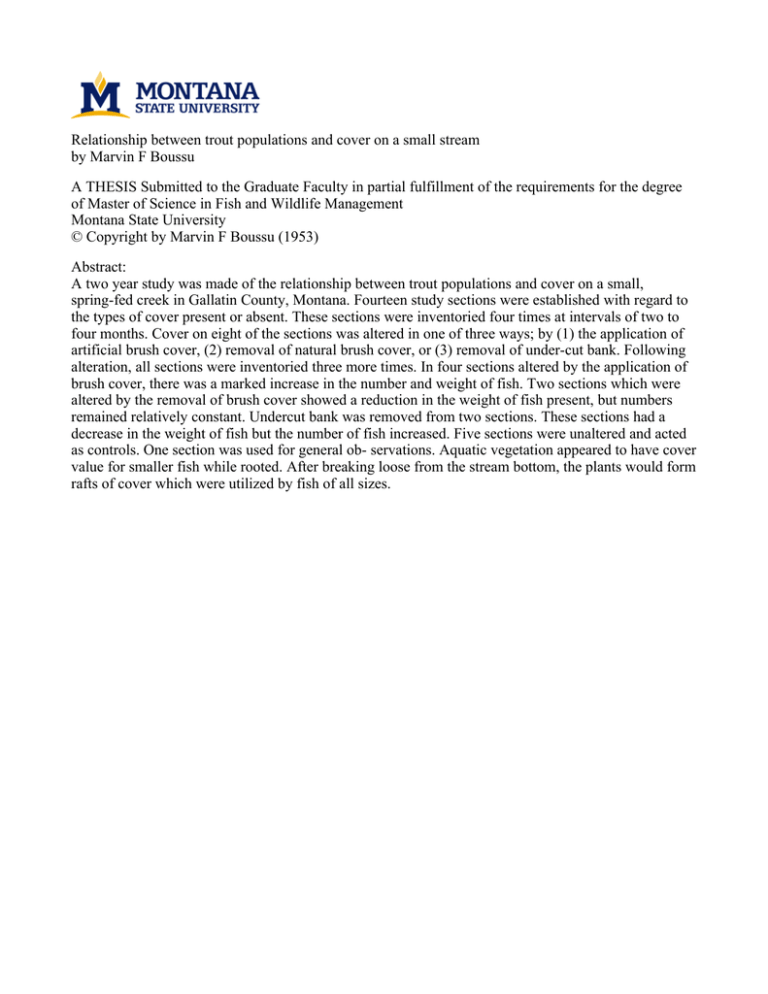
Relationship between trout populations and cover on a small stream by Marvin F Boussu A THESIS Submitted to the Graduate Faculty in partial fulfillment of the requirements for the degree of Master of Science in Fish and Wildlife Management Montana State University © Copyright by Marvin F Boussu (1953) Abstract: A two year study was made of the relationship between trout populations and cover on a small, spring-fed creek in Gallatin County, Montana. Fourteen study sections were established with regard to the types of cover present or absent. These sections were inventoried four times at intervals of two to four months. Cover on eight of the sections was altered in one of three ways; by (1) the application of artificial brush cover, (2) removal of natural brush cover, or (3) removal of under-cut bank. Following alteration, all sections were inventoried three more times. In four sections altered by the application of brush cover, there was a marked increase in the number and weight of fish. Two sections which were altered by the removal of brush cover showed a reduction in the weight of fish present, but numbers remained relatively constant. Undercut bank was removed from two sections. These sections had a decrease in the weight of fish but the number of fish increased. Five sections were unaltered and acted as controls. One section was used for general ob- servations. Aquatic vegetation appeared to have cover value for smaller fish while rooted. After breaking loose from the stream bottom, the plants would form rafts of cover which were utilized by fish of all sizes. RELATIONSHIP BETWEEN TROUT POPULATIONS . AND COVER ON A SMALL STREAM » ■ ' MARVIN F. BOUSSU A THESIS ' Submitted to the Graduate Faculty in partial fulfillment of the requirements for the degree of Master of Science in Fish and Wildlife Management at .Montana State College Approved J or Be; Chaij^ian, !Examining Committee Db a n G r a d u a t e Division Bozeman, Montana June, 1953 5 « *" j£> (jL»$ r \ TABLE OF CONTENTS Page Abstract ....................................................... 3 Introduction .............. It Description of creek ....................................... U Species of fish present 5> .................. ................ Selection of study sections ............................. . 5 Alteration of cover ........................... ............. 6 Inventory methods ................ 8 8 Application of brush cover .................. *........ . Removal of brush cover .............. ..................... . 13 Removal of under-cut bank ................... ...... ......... . 18 Aquatic vegetation ................................. ....... . 20 Rooted aquatic vegetation .............. ................. . 22 Detached aquatic vegetation ........................... . ... 23 Acknowledgements .......................................... 2lt Summary ............................ ...... ........... .......... . 2lt Literature cited ............... ... 25> ............. 10S726 ABSTRACT A two year study was made of the relationship between trout popu­ lations and cover on a small, spring-fed creek in Gallatin County, Mon­ tana. Fourteen study sections were established with regard to the types of cover present or absent. These sections were inventoried four times at intervals of two to four months.. Cover on eight of the sections was altered in one of three ways; b y (I) the application of artificial brush cover, (2 ) removal of natural brush cover, or (3 ) removal of under-cut bank. Following alteration, all sections were inventoried three more times. In four sections altered by the application of brush cover, there was a marked increase in the number and weight of fish. Two sections which were altered b y the removal of brush cover showed a reduction in the weight of fish present, but numbers remained relatively constant. Under­ cut bank was removed from two sections. These sections had a decrease in the weight of fish but the number of fish increased. Five sections were unaltered and acted as controls: One section was used for general ob­ servations. Aquatic vegetation appeared to have cover value for smaller fish while rooted. After breaking loose from the stream bottom, the plants would form rafts of cover which were utilized by fish of all sizes. . -Ii- • INTRODUCTION The preference of trout for stream areas with protective cover has "been recognized for a long time. . In England, for example, the establish­ ment of artificial "lies", which act as shelter for trout, has been practiced for many years. Greeley (1936), Tarzwell (1937, 1938), and Shelter, Clark, and. Hazzard (19U6) are among those who have investigated the influence of cover on trout in this country. Their studies have shown that stream improvement, including the use of artificial cover, can O increase the number and size of trout in a given section of stream. Physical improvements used on streams often incorporate the use of shelters along with deflectors, low dams, and other structures. Uhile 'there is considerable information on the over-all effect of stream im­ provement, little quantitative data have been presented on the extent to which various types of cover affect trout populations. The present study is concerned with the relation between trout populations and (l) the various kinds of natural cover in a small stream, (2 ) the effect of par­ tial or complete removal of natural' cover, and (3) the application of artificial coyer to areas naturally devoid of such protection. The stream selected (Trout Creek) is located about 3& miles northeast of Belgrade, Gallatin County, Montana. It originates primarily in springs and meanders through flat, cultivated and pasture lands for a distance of about four miles before emptying into the East Gallatin River. to £ feet in width near its source and widens to approximately the region adjacent to its mouth. It is 3 2$ feet in Trout Creek remains free of ice throughout the year. The highest water temperature recorded during the study period (June, 195>1 - March, 1953) was 63 degrees F. and the lowest 39 degrees F. Bank vegetation in the upper third of the stream is composed princi­ pally of heavy, alternating growths of sedge (Carex nebraskensis and C. rostrata) and willow (Salix sp.). abundant in the area. These two types are about equally In the middle third there is short-grass pasture with only occasional clumps of willow bordering the stream. The lower one-third, which did not include any study sections, supports a dense growth of willows. Aquatic vegetation was abundant during certain times of the year. 'Watercress (Nasturinm officinale), water speedwell (Veronica connata), pondweed (Potamogeton sp.), brook grass (Catabrosa aquatica), and several species of algae were found. The most important- aquatic plants from the standpoint of cover were watercress and a grass-green algae, Enteromorpha intestinalis. Fish present included rainbow trout (SaImo gairdnerii), eastern brook trout (Salvelinus fontinalis), and brown trout (Salmo trutta), with the first two comprising about 98 per cent of the total trout population. Qn one occasion ten whitefish (Prosopium williamsoni) were found. Fresh­ water sculpins (Cottus sp.), while common, were not included in popu­ lation figures. The presence, or absence of natural cover, such as overhanging willow, under-cut banks, etc., served as a basis in the selection of lU study -6- sections. 58 feet. These varied in length from 39 to 98 feet, with an average of M d t h s ranged from Ii to 21 feet, with an average of 10 feet. The water area, depth, cover, and other physical data were determined for each section. Variations in cover were recorded at the time of each popu­ lation inventory. The water areas in each.section were classified as either riffle, flat water, or pool. These categories are defined as followss ' ■Riffles (l) surface waters choppy, (2) average depth shallow - u n d e r 8 inches, (3) increased water velocity, (Ii) bottom of coarse sand or gravel. Flat water's (l) surface waters smooth, (2) depth variable, (3) moder­ ate velocity maintained through area and flow usually in a straight course, (U) bottom of silt or fine sand. Pool: (I) surface waters quiet, although some swirls may be evident, C2) comparatively deep - over 12 inches, (3) appreciable reduction in water velocity, often associated with a change in stream course or some obstruction, (U) bottom of silt or clay pan. Inventories were taken four times in each section? cover on eight of the sections was then altered and all sections inventoried three more times. The first four inventories will be referred to as "pre-alteration", and the last three as "post-alteration". The elapsed time from one com­ plete series of inventories to the next varied from 2 to 5 months. Each series was completed as quickly as. possible (usually less than a week) to minimize any variations which might arise from population fluctuations. To East Gallatin River. TROUT CREEK STUDY SECTIONS 1. BRUSH COVER APPLIED 2. GENERAL OBSERVATION 3. CONTROL ON U U. BRUSH COVER APPLIED 5. CONTROL ON 6 AND 8 6 . UNDER-CUT REMOVED 7. BRUSH COVER REMOVED 8 . UNDER-CUT REMOVED 9. BRUSH COVER APPLIED 10. CONTROL ON 9 11. CONTROL ON 7 AND 12 12. BRUSH COVER REMOVED 13. CONTROL ON lU lU. BRUSH COVER APPLIED MILE Fig. I, Trout Creek 1 r r-8- . Control sections (those not altered) were usually inventoried the same day as the corresponding experimental sections«, Individual sections were isolated by use of blocking nets during population inventories. Fish were collected (shocked with a 25>0 watt D. C. generator), weighed, measured, and returned to the water. All fish collected from a section (sculpins excepted) were measured to the nearest 0.1 inch (total length) and weighed to the nearest 0.01 pound. Diffi­ culties in weighing fish during winter operations necessitated the appli­ cation of length-weight data to obtain certain of the weights used. The fish were arbitrarily divided into three length groups s legal, 7 inches or over; sub-legal, LwO to 6.9 inches; and fingerling, less than LuO inches« APPLICATION OF BRUSH COVER Cover devices were applied to four sections. These consisted of plank frames with interwoven willow branches (Fig. 2). ranged from l£ to £0 square feet. Their sizes An attempt was made to simulate natural willow cover in density and position. All devices were installed at least one month before any post-alteration inventories were made in the sections where they occurred. The total area of cover applied- to the four sections w a s l£ 5> square feet. While the rate of increase for individual sections varied, there was a marked increase in numbers and pounds of fish in each of the experi­ mental sections. A description of the experimental and control sections, and the results obtained are as follows: Section I: This section was primarily flat water, but two pools' (maximum depth 2h inches) were present. Overhanging cover was non­ existent, however, a total of Iu 6 square feet of under-cut occurred near one end of the section. This under-cut was believed to be largely in­ effective as cover due to the shallow water associated with it. Aquatic vegetation was sparse; only a small patch being present, at the head of each pool. The length of this section was 88 feet; average width 163 inches; average depth 12.9 inches. Fifty square feet of brush cover was placed over the pool areas. The numerical increase in legal size fish .following the application of cover was less than either that of sub-legals or fingerlings, but the weight increase was several times that of the latter two combined. The increase in weight of legals was much greater than in other sections where brush cover was applied; the increase of sub—legals smaller. This may have resulted from the presence of three large brown trout which utilized the cover device. Most of the fish were concentrated in the pool areas both before and after the application of brush cover. The pre-alteration and post-alteration averages per inventory were as followss Legals l.£0 (0.29 pounds) to U.00 (2.97 pounds); sub-legals 7 .5 0 (0 .U7 pounds) to 1 2 .6 0 (0.5U pounds), and fingerings. 5.20 (0.05 pounds) to 29.33 (0.25 pounds). The' average total pounds per inventory previous to cover application was 0 .81 ; following application this increased to 3*76» Section Ii.; Previous to alteration this section was composed entirely of flat water without pools, cover, or under-cut banks. Aquatic vegeta­ -10tion was sparse, 219 inches. Xt had a length of £l feet, and an average width of The average depth was 11.7 inches, but a channel near one edge of the stream averaged about l£ inches in depth. tended through the entire section. of This channel ex­ Two brush covers having a total,area square feet (ill. and 3 1 ) were installed at mid-section over the channel. Following cover application there was an increase in the number and weight of fish. No legals, and only one sub-legal fish, were found during the pre-alteration inventories. legal and U.3 sub-legals. per inventory to 19.30, Post-alteration inventories averaged one Fingerlings increased from an average of Iu25 The pre-alteration and post-alteration weights were as followst legals, 0 - 0 .Ull-J sub-legals, 0 .02 - 0 .23J fingerlings, 0.02-0.18. The average total pounds per inventory was O.Oit previous to alteration and 0 .8 6 post-alteration. Section 3: Located about 300 yards downstream from section It, this section had much the same physical characteristics as the experimental ■ section with the exceptions of a shallower depth (average 9.L inches), and more abundant aquatic vegetation. No alterations were made in this section. During the first four shockings, the population corresponded to that in section Ii. growth. Both supported a few small fish during periods of aquatic "Whereas the experimental section had an average increase in total pounds of 0 .8 2 per inventory, section 3 changed relatively liitle with an increase of 0 .0 1 (0.02 - 0.03) pounds. Section 9: Flat water, was predominate in this section (approximately —H — 60 per cent), although about 10 per cent of the upper end was riffle areae One pool (maximum depth, 15>*0 inches) and 3=0 square feet of under-cut bank were present. There was no overhanging cover. Aquatic vegetation was abundant, especially from late summer to mid-winter. length of this section was £2 feet; average depth 6.0 inches. The the average width 119 inches; the A brush cover of the same size (1|3>.0 square feet) and type as used in section It was placed over the pool area. . .The increase in total pounds in this section was twice that of section It. The increase in pounds of legals was nearly the same in both sections; the larger increase in this section being made up of sub-legals and fingerlings. Extensive beds of watercress were present in section and were practically lacking in section It, during the inventories of September and December, 1952. in section 9. This may account for the larger increase Average numbers and weights of fish per inventory in section 9 before and after alteration are as follows; legals, 2.25 (0 .3 1 pounds) to It. 66 (0 .7 9 pounds); sub-legals, 1 2 .0 0 .(0.58 pounds) to 30.00 (1.39 pounds); fingerlings, 19.25 (0.13 pounds) to ItO.OO (0.5l pounds). The .total pounds per pre-alteration inventory averaged 1.02 and post-alteration, 2.69. Section 10; This section was used as a control for section 9, and was located about ItO feet upstream from the experimental section. Physi­ cal characteristics of the two sections corresponded except that there were two pools in the control section (maximum depths of 16 and 18 inch­ es), and. the average depth was greater (9 .0 inches). -12The increase in average total pounds per inventory was liU5> per cent (!»30 - 1 081|) for the control section compared to l6 3 e7 per cent (1 .0 2 2.69) for the experimental section. This increase may have resulted from uprooted aquatic vegetation forming rafts of temporary cover during the September and December, 195>2 inventories. Biese natural covers were 11 and 18 square feet in extent respectively. Several legals were known to utilize this shelter. Section lU? This section, located in the uppermost part of the stream, was composed entirely of flat water. Uo pools were present, but under-cut banks were extensive (22.3 square feet). Heavy growths of sedge overhung the banks from mid-summer to early winter. From the data obtained, it was not possible to correlate this grass cover with popu­ lation fluctuations. This section was 3l feet in length; L3«3 inches in ,average width, and 3«1 inches in average depth. In proportion to the area of cover applied, the actual numerical and weight increases were greater in this section than in other sections which received like treatment. The average number of legals present per inventory before application of cover was 0 .73.(0.13 pounds); after application, 2.00 (0.33 pounds). The number of sub-legals increased from 8.13 (O.ltl pounds) to 18.7b (I.03 pounds); fingerlings from 9.00 (0.09 pounds) to 13.33 (0.20 pounds). The total pounds per inventory averaged 0 .6 2 previous to cover application, and 1 .6 0 following application. Section 1 3 : This section was the control for section lU. Physical characteristics of the two were similar with the following exceptions: -13The control section contained It square feet less under-cut 5 the average depth (6 .8 inches) was greater, as was the average width (75> inches). Bank vegetation, water type, and section length were approximately the same as in section 15>.. The increase in average total pounds per inventory was 9»2 per cent (l.7lt - 1 .90 ) in the control section and l£ 8 .1 per cent (0 .6 2 - 1 .60 ) in the experimental section. Although there was an increase in total pounds, the control section showed a smaller post-alteration number of fish in all size classes. A brown trout, weighing 2.7 pounds, captured during the December, 1952 inventory accounted for this weight increase. There is no obvious explanation why this section held a consistently higher pre-alteration pounds of fish than section 15, which had U square feet more under-cut, although average width and depth were greater. The increase in total pounds of fish following the application of brush cover to four experimental sections amounted to 2 5 8 .1 per cent. The three sections which were unaltered increased an average of 22.5 per cent. There was an average increase in legals of 0.62 pounds per inven­ tory per 100 square feet of cover applied (Table I). REMOVAL OF BRUSH COVER . . Overhanging brush cover was removed from two sections, 7 and 12. This was accomplished by chopping the overhang back to bank level at least five weeks before the first post-alteration inventory. square feet of cover was removed from the two sections. used as a control. Approximately 128 Section 11 was BRUSH COVER APPLICATION Table I* Average ntmiber and pounds (in parentheses) of fish per inventory, pre-alteration - post-alteration. Control Sections 3; 10, 13 ' pre-alt. post-alt. Experimental Sections I, L, 9, 15 post-alt. pre-alt. 2.66 (0.U7) 2.66 (0«6l) 1 8 .1 6 (0.80) 9.25 (0.U7) 6.66 (0.30) 9ok3 (0.07) 25.50 (0.28) 9.66 (0 .0 8 ) 10.UU (0.13) 17.IiU (0.62) U5.25 (2.22) 21.58 (1.02) 19.77 (1.25) Legals 1.12 ( 0. 18) 3.00 (l.lU ) Sub-Iegals 6.87 (0.37) Fingerlings All Fish . BRUSH COVER REMOVAL Table II. Average'timber and pounds (in parentheses) of fish per inventory, pre-alteration - post-alteration Experimental Sections 7 and 12 post-alt. pre-alt. Control"Section 11 post-alt. pre-alt. 7.33*(1.36) Legals 11.UO (2.09) 5.18 (0.87) 6.75 (l.oo) Sub-Iegals 3U.25 (1.96) 26.66 (l.2U) 28.75 (1 .62 ) Fingerlings 21.77 (0.18) 35.16 (Q.Ul) 1 U .75 (0.15) ' 12.00 (0 .1 U) All Fish 66.12 (U.22) 67.00 (2.5l) 50.25 (2 .77) 25.33 (1.U5) UU.66 (2.95) Section _7: This section was principally flat water and was located immediately downstream from a short riffle area. Two pools were present; one without cover and the other having about 98 square feet of willow cover. Maximum depth in the open pool was 1 9 inches s and in the covered pool, 18.0 -inches. Another willow (19 square feet) overhung shallow water .at dne end of the section. About 9 square feet of under-cut bank was present under the willow overhanging the pool. Aquatic vegetation was abundant with beds of watercress totaling about 70 square feet in extent being present during both seasons. The length of this section was 99 feet; average width 196 inches, and average depth 9.8 inches. This section was altered b y removing the 98 square feet of willow covering the one pool (Figs. 3 and U ) . Previous to the removal of this cover, the average number of legals per inventory was 12 (2.37 pounds). (0o80 pounds). Following removal, the average was h The number of- sub-legals decreased from an average of 38.79 (2.08 pounds) to 33.00 (1.26 pounds) per inventory. Fingerlings increased from !48.7U (0.23 pounds) to 88.90 (0.67 pounds). There was a decrease in total pounds from a pre-alteration average of I4.69 to a post­ alteration average of 2.73 per inventory. Secticn 12s Flat water predominated in this section but a short stretch of riffle and one pool with a maximum depth of 21 inches were present. Thirty square feet of brush cover overhung this pool. Approxi­ mately 6 square feet of under-cut bank occurred in the upper part of the section. During the September and December inventories there was approximately 26 square feet of aquatic vegetation present. This section -16- Fig. 2. Artificial brush cover. Fig. U. Section 7 after brush cover removed. Section 9. -17was 62 feet in length; 76 inches in average width, and 8.0 inches in average depth. Alteration was accomplished b y removing the 30 square feet of cover overhanging the pool. The average number of legals per inventory previous to cover removal was 10.75 (l.8l pounds). Following cover removal, this dropped to an average of 6.33 (O.9I1 pounds). Sub-Iegals decreased from an average of 29.75 fish (.1.83 pounds) per inventory to 20.33 (1.21 pounds). The number of fingerlings decreased from 12.50 to 11.00, but increased in weight from 0.12 to O.lU pounds. There was a decrease in total pounds of fish from an average of 3.76 per inventory previous to cover removal, to 2@29 following alteration. Section Ili This section was entirely flat water with the exception of one pool having a maximum depth of 17 inches. There was approximately 70 square feet of willow cover overhanging the pool area, and about 15 square feet of under-cut bank present. Aquatic vegetation was sparse at all times; the maximum area at any time being less than 10 square feet. The section length was 5U feet; average width 79 inches, and average depth 7.7 inches. No alterations were made in this section. The average number of legals per inventory for the' first four shoek- ings was 6.75 (1.00 pounds); this increased to 7=33 (1.36 pounds) for the last three shockings. 'Sub-Iegals decreased from 28=75 (1.62 pounds) to 25=33 (1.U5 pounds). Fingerlings also decreased from lit=75 (0.l5 pounds) to 12.00 (O.lU pounds). There was an increase in the average total pounds per inventory from 2.77 to 2.95. Total pounds per inventory increased an average of 6.5 per cent in »18the control section® The total pounds decreased 1|0®5 per cent in the sections Tahere cover was removed. There was a weight increase in legals of 360 O per cent in the control section and a decrease of in the experimental sections® per cent legals decreased an average of 0 =95 .pounds per inventory per 100 square feet of brush cover removed (Table IT). REMOVAL OF UHDER-CUT BAEK Under-cut banks were partially removed from two sections 5 6 and 8 ; section 5 was used as a control. Removal was accomplished b y spading back the overhanging bank to the outermost edge of the stream® amount of under-cut removed was about 15 square feet® The total Under-cut formed by stream action subsequent to removal was allowed to remain. The amount of newly formed under-cut was measured for each of the post-alteration inventories and averaged between them. At least four weeks elapsed be­ fore any post-alteration inventories were taken on the sections concerned. Section 6 : This section had almost equal amounts of riffle 5 flat water and pool. The pool occurred at a sharp bend and had a maximum depth of 18.0 inches® No overhanging cover was present® The area of . under-cut previous to alteration was approximately 15 square feet. .The largest part of this occurred in conjunction with the pool; a smaller amount with riffle and flat water. abundant. Aquatic vegetation was moderately A bed of watercress (about 20 square feet) was present near the upper end of the section from late summer to mid-winter. Several variable small patches of brook grass and pondweed were found in mid­ stream throughout the year. The length of this section was 53 feet, the — 19average width IlIi inches, and the average depth 9«,7 inches. Alteration consisted of removing 10 of the If? square feet of under-cut present* The change in numbers of f i s h .(average per inventory) before and after alteration was as follows: legals decreased from 2.f?0 (0o?0 pounds) to 1.66 (0.32 pounds); sub-legals increased from lu7E> (0.2f> pounds) to 6.66 (0.26 pounds), and fingerlings from 7®2f? (0.07 pounds) to 11.00 (0.13 pounds). The decrease in average total pounds per inventory, pre­ alteration to post-alteration, was from 1.02 to 0.70. There was an 'in­ crease in the average number of fish per inventory from llt.f?0 to 19.33. Section 8s This section was entirely flat water with no overhanging cover. The under-cut bank previous to alteration was about 7 square feet in extent. Aquatic vegetation was moderately abundant (approximately 3f? square feet) throughout the year, and was composed principally of brook grass. The length of this section was 39 feet; average width H O inches, and average depth f?.f? inches. Approximately f? square feet of under-cut bank was removed. The change in the fish population per inventory before and after alteration-was as follows; Legals, 1,2$ (0.19 pounds) to 0; sub-legals Lu7!? (0.23 pounds), to 3.66 (0.12 pounds); fingerlings 12.71? (0.07 pounds) to 13o66 (0.18 pounds). The average total pounds per inventory was 0.18 previous to alteration and 0.29 following alteration. There was also a . numerical decrease of 1.U3 fish per inventory (l8.71? - 17*32). Section cover. $t This section was entirely flat water with no overhanging Approximately 21 square feet of .under-cut bank was present. «*20' Aquatic .vegetation was moderately abundant throughout. It had a length of 1+8 feet; average width 120 inches, and average depth 8.$ inches. This section was used as a control and no alterations.were made. The change in numbers and weights of fish per inventory from the first four to the last three inventories was as follows: Legals, 3®2£. (0.91 pounds) to 3.00 (0„30 pounds); sub-legals, 8.2 3 (0Ji2 pounds) to 22.00 (0.93 pounds); fingerlings, 1 1 .30 (0.09 pounds) to 23.00 (0.23 pounds). The change in the average total pounds per inventory was from 1.1*2 to 1.70. The numbers of fish increased from 23 to 1*8. The average decrease in pounds per inventory for the experimental sections was 33.3 per cent. The control, section increased 19.7 per cent during the same period of time. There was an average decrease of 1.66 pounds per inventory per 100 square feet of under-cut removed (Table TH). \ AQUATIC VEGETATION While no sections were devoted exclusively to the study of aquatic vegetation as cover for fish, observations and measurements of plant growth were made on several of the sections used in other experiments. Aquatic vegetation appeared to have value as cover both while rooted and after becoming detached. While rooted, plants are extensively utilized as cover, especially by the smaller fishes. After breaking loose from the bottom, plants form floating rafts which lodge against overhanging brush or collect in quieter areas of the stream (Fig« These were known to be utilized by fish of all sizes. 3)• UNDER-CUT REMOVAL Table H T . Average number and pounds (in-parentheses) of fish per inventory, pre-alteration - post-alteration Experimental Sections 6 and 8 post-alt. pre-alt. ' Control Section 5 pre-alt. post-alt. Legals 1.88 (OeB ) 0.83 ( 0. 16) 3.25 (0.91) 3.00 (0.50) Sub-Iegals . U.7$ (0*210 5*17 (0.19) 8.25 (0.U2) 22.00 (0.95) ,Fingerlings 10.00 (0.07) 12.33 (0.15) 11.50 (0.09) 23.00 (0.25) All Fish 16.63 (0.75) 18.33 (0.,50) 23.00 (1.U2) 18.00 (1.70) -22Watercress appears about July, and as the summer progresses it forms extensive beds in some of the sections. These begin to break up in Nov­ ember or December, and by the latter part of March are almost completely gone. Zn those sections having extensive beds of watercress, the areal abundance was approximately the same for both years (1951-1952). grass and pondweed were also present in some of the sections. Brook- These plants formed underwater mats which remained quite constant throughout the year. Rooted Aquatic Vegetation Combining all sections, the post-alteration inventories showed a higher average number and weight of fingerlings than did those inventories taken prior to alteration. This was probably the result of no post­ alteration inventories being taken in July when fingerling populations were low, due to seasonal fluctuation (Holton, 1953), whereas two pre­ alteration inventories were taken during this month. Fingerlings increased (pre-alteration to post-alteration) in a l l . sections except 11. However, it was not possible to correlate these in- creases with the manipulation of cover. In those sections where aquatic vegetation was sparse, fingerlings tended to follow the same population trends as shown by legals (sections I and It). The presence of abundant aquatic vegetation evidently tempered, or even reversed this tendency, as a comparison of sections 7 and abundant aquatic vegetation. 9 shows. Both of these sections possessed In section 9 the application of cover was followed by an increase in legals (0.1t8 pounds, average per inventory). . : •"23" and an increase in fingerlings (0.38), In section 7 the removal of cover was followed by a redaction in legals (1.57 pounds 5 average per inventory), and an increase in fingerlings (O1ItU)* The decrease in legals in this section was the largest of all sections; the increase in fingerlings the largest of all sections. There was no apparent effect of rooted aquatic vegetation on the abundance of legal fish. Detached Aquatic Vegetation The use of aquatic vegetation as temporary cover after it had broken loose and formed rafts, was noted on several occasions. Section 10 pos­ sessed this type of cover in December, 1952 and again in March, 1953* Several .large fish were found utilizing this cover. Section 2 demon­ strated the value of free-floating aquatic vegetation as cover. This section contained a deep pool with overhanging willow cover. . During the first three inventories, the willow branches which extended into the water were clogged with floating materials - much of which was aquatic plants. This formed a dense, mat-like covering which disappeared some­ time between the March and July, 1952 inventories, leaving only the willow branches as coyer. The average weight of fish in this section was 5.6 pounds per inventory previous to the loss of this cover, and 1.6 pounds after; a reduction of 71 per cent. were observed which might account for this. Mo other ecological changes ACKNOWLEDGEMENTS The writer wishes to acknowledge and extend thanks to Dr. C e J . D e Brown who suggested and gave overall direction to this study, and helped in preparation of the manuscript. Several students at Montana State College gave valuable assistance in the collection of field data. Special acknowledgement is given George D. Holton and LeRoy Ellig in this respect. The Montana Fish and Game Department provided equipment for much of the field work and the Montana State College Agricultural Experi­ ment Station gave financial assistance. SUMMARY 1. A study was made of the relationship of eastern brook trout, rainbow trout, and brown trout populations to cover in Trout Creek, Gallatin County, Montana. 2. Fourteen sections were established as study areas. These sections were selected on the basis of presence or absence of cover features such as overhanging brush and under-cut banks. 3. Fish were collected by shocking and arbitrarily classified into three length groups; legals, sub-legals, and fingerlings. U. All sections were inventoried four times prior to alteration (July, December, 19^1; March, July, 1952). altered. Cover on eight sections was Five sections were unaltered and used as controls. One section was used for general observations. 5. fl~n sections were inventoried three times following alteration (Sep­ tember, December, 1952; March, 1953). A comparison of pre-alteration and post-alteration populations was made. 6. A total of 15& square feet of brush cover was applied to four sections. The increase.in total pounds following this application averaged 1,60 per inventory. The populations in three control sec­ tions increased by an average of 0.23 pounds per inventory. 7. A total of 128 square feet of natural brush cover was removed from two sections. The decrease in total pounds of fish per inventory following this removal was 1.71. • A control section increased in total pounds by an,average of 0„l8 per inventory. 8. Fifteen square feet of under-cut bank was removed from two sections. The decrease in' total pounds per inventory following this removal was 0.2$. The control section increased in total pounds an average of 0.28 per inventory. . 9. Aquatic vegetation appeared to be of value as cover when rooted to the stream bottom and also while free-floating. LITERATURE1 CITED Greeley, John R. State. 1936. Progress of stream improvement in New York Trans. Am. Fish Soc., 6$(l93$)016-321. Holton, George D. 19$3. A trout population study on a small creek in Gallatin County, Montana. Jour. Wildl. Mgt., 1 7 s62-82. Shelter, David S., 0. H. Clark, and Albert S . Hazzard. 19U6• The effects of deflectors in a section of a Michigan trout stream. Trans. Am. Fish. Soc., 76(l9U6);2U8-278.■ «26* Tarzwell, Clarence M. 1937. Experimental evidence on the value of trout stream improvement in Michigan. Trans. Am. Fish. Soc., 66(1936):177-187. ------------ : 1938. An evaluation of the methods and,results of stream improvement in the southwest. Trans. N. A. Wildl. Conf., 3039-361).' 'O 106726 .....r-rsCTTV ITRHfcRIES 3 1762 10012930 1 Boussu, Marv:'n •po-)o+.-innaVii p bP-t.wssn +.unut DATE_jpo|ulotiouF! *%^"Bcrver NOV 2 C 10p IN l F n L I u R A n Y LO A N ,v MPfllSn ^ I . -.iH p*/St* //Ufj &4 N378 B U S r Co^ L i-O /r. Crv^ I.*/ w \ I ■' --t- 1CG726


